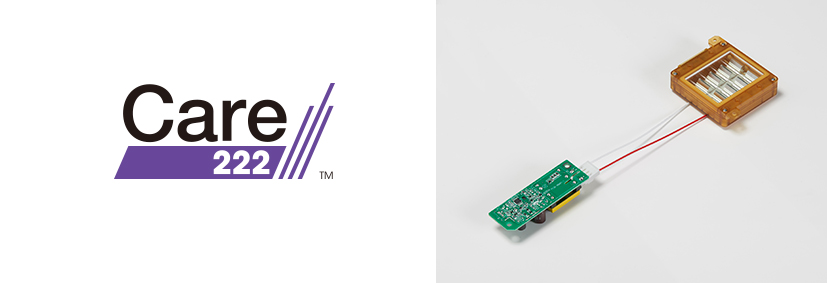
COVID-19: Demonstration of virus inactivating effect: Care222TM UV
~Expected to be applied to infection control~
reaserch result:
For the first time in the world, we have revealed the inactivating effect of the new coronavirus by the central wavelength of 222 nm.
222nm UV light is safer for human eyes and skin than 254nm UV light. It is expected to be applied to infection control against new coronavirus infectious diseases.
Hiroshima University Hospital: USHIO INC.
The group of Professor Takemasa Sakaguchi of Virology at Hiroshima University Hospital is Care222TM USHIO INC.
Was used to clarify the effect of inactivating the new coronavirus for the first time in the world.
Care222TM:
An ultraviolet lamp manufactured by USHIO INC.
The ultraviolet light output from the KrCl excimer lamp
Narrow wavelength with filter,
Ultraviolet lamp in the 200-230 nm region with a peak of 222 nm.
Inactivating effect:
In a dry environment on plastic,
222 nm UV with an illuminance of 0.1 mW/cm2,
By irradiating for 30 seconds,
99.7% of new coronavirus inactivation was confirmed.
The results of this research were published in the online version of the American Journal of Infection Control.
Hiroshima University
https://www.hiroshima-u.ac.jp/news/59996
https://www.hiroshima-u.ac.jp/news/59996
Effectiveness of 222-nm ultraviolet light on disinfecting SARS-CoV-2 surface contamination – American Journal of Infection Control
Highlights
•222-nm UVC light (0.1 mW/cm2) reduced viable SARS-CoV-2 by 0.94 log10 in 10 s•222-nm UVC light (0.1 mW/cm2) reduced viable SARS-CoV-2 by 2.51 log10 in 30 s•222-nm UVC light did not reduce SARS-CoV-2 RNA copy number after 5 min irradiation•TSID50 and not RT-qPCR should be used to monitor far-UVC disinfection of surfaces
Abstract
Background
Severe acute respiratory syndrome coronavirus 2 (SARS-CoV-2), which causes coronavirus disease 2019 (COVID-19), has emerged as a serious threat to human health worldwide. Efficient disinfection of surfaces contaminated with SARS-CoV-2 may help prevent its spread. This study aimed to investigate the in vitroefficacy of 222-nm far-ultraviolet light (UVC) on the disinfection of SARS-CoV-2 surface contamination.
Methods
We investigated the number of viable SARS-CoV-2 after UV irradiation (0.1 mW/cm2) at 222 nm for 10–300 s using the 50% tissue culture infectious dose (TCID50). In addition, we used quantitative reverse transcription polymerase chain reaction to quantify SARS-CoV-2 RNA under the same conditions.
Results
One and 3 mJ/cm2 of 222 nm UVC irradiation (0.1 mW/cm2 for 10 and 30 s) resulted in 88.5 and 99.7% reduction of viable SARS-CoV-2 based on the TCID50 assay, respectively. In contrast, the copy number of SARS-CoV-2 RNA did not change after UVC irradiation even after a 5-min irradiation.
Conclusion
This study shows the efficacy of 222-nm UVC irradiation against SARS-CoV-2 contamination in an in vitro experiment. Further evaluation of the safety and efficacy of 222-nm UVC irradiation in reducing the contamination of real-world surfaces and the potential transmission of SARS-CoV-2 is needed.
https://www.ajicjournal.org/article/S0196-6553(20)30809-9/fulltext